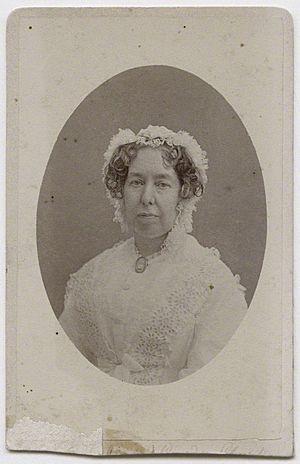Mary Cowden Clarke facts for kids
Quick facts for kids
Mary Cowden Clarke
|
|
|---|---|

Portrait of Mary Cowden Clarke, c. 1870
|
|
| Born |
Mary Victoria Novello
22 June 1809 London, England
|
| Died | 12 January 1898 (aged 88) Genoa, Italy
|
| Occupation | Author |
| Spouse(s) |
Charles Cowden Clarke
(m. 1828; |
Mary Victoria Cowden Clarke (born Mary Victoria Novello; June 22, 1809 – January 12, 1898) was an English writer. She is best known for creating a complete guide to all the words used in William Shakespeare's plays, called a concordance. She also used the pen names M. H. and Harry Wandsworth Shortfellow.
Contents
Early Life and Learning
Mary Victoria Novello was born in London, England, on June 22, 1809. She was the oldest of eleven children. Her father, Vincent Novello, was a famous musician.
Growing up, Mary met many important artists and writers at her family's home. These included painters like John Varley and writers like Charles and Mary Lamb, Leigh Hunt, and John Keats. Mary Lamb, who was a writer herself, even taught young Mary Latin and how to read poetry. These early lessons helped Mary develop her love for books and writing.
For her formal education, Mary went to a school in Boulogne-sur-Mer, France.
Becoming a Writer
After returning to England, Mary worked for a short time as a governess, teaching children in a family. However, she had to stop because she wasn't feeling well.
In 1827, she published her first piece of writing, "My Arm Chair," using the initials "M. H." This was followed by other short articles.
Marriage and the Shakespeare Concordance
On July 5, 1828, Mary Novello married Charles Cowden Clarke. Charles was a close friend of her family and her brother's business partner. They continued to live with Mary's family for some time after their wedding.
The year after she married, Mary Cowden Clarke started working on her most famous book: a concordance to Shakespeare. This huge project involved listing every single word Shakespeare used in his plays and where to find it. It took her twelve years to put it all together and another four years to get it printed! The book was finally published in 1845. It became a very important tool for anyone studying Shakespeare.
Acting and New Works
Mary Cowden Clarke also enjoyed acting. In 1847 and 1848, she performed in some amateur plays. These performances led her to meet the famous writer Charles Dickens. Dickens asked her to join his amateur acting group, which put on shows to raise money for Shakespeare's birthplace in Stratford-on-Avon.
Mary played several roles, including Dame Quickly in The Merry Wives of Windsor. She performed with Dickens's group in London and other cities like Liverpool and Edinburgh.
While acting, Mary also continued to write about Shakespeare. In 1848, she published Shakespeare Proverbs. Between 1850 and 1852, she wrote a series of fifteen stories called The Girlhood of Shakespeare's Heroines. These stories imagined what Shakespeare's female characters were like when they were young.
From 1853 to 1856, Mary was the editor of The Musical Times, a magazine about music. She also wrote many articles for it, exploring "Music among the Poets."
Life in Italy
In 1856, Mary and Charles Cowden Clarke moved to Italy permanently. They first lived in Nice and then moved to Genoa in 1861, after her father, Vincent Novello, passed away. Their home in Genoa was even named Villa Novello.
While in Italy, Mary continued to write. She published World-noted Women in 1858, which was about famous women throughout history. She also edited an edition of Shakespeare's Works in 1860 and wrote a book about her father, The Life and Labours of Vincent Novello, in 1864.
Mary and her husband also worked together on an annotated edition of Shakespeare's plays. This means they added notes and explanations to the plays. After finishing this, they started another big project called The Shakespeare Key. This book was a companion to her earlier concordance, helping readers understand Shakespeare's writing style.
Later Years
Charles Cowden Clarke passed away in 1877. The next year, Mary returned to England to oversee the publication of their shared memories, called Recollections of Writers. This book included letters and stories about their famous friends like John Keats and Charles Dickens.
Mary visited England again in 1881. In 1887, she wrote a short biography about her husband to celebrate what would have been his 100th birthday. In 1896, she published her own life story, called My Long Life.
Mary Cowden Clarke died at her home in Genoa, Italy, on January 12, 1898, at the age of 89.
Selected Works
Here are some of the books Mary Cowden Clarke wrote:
- Kit Bam's Adventures: or, The Yarns of an Old Mariner (1849)
- Concordance to Shakespeare (1846) - Her famous guide to Shakespeare's words.
- The Girlhood of Shakespeare's Heroines (1850) - Stories about Shakespeare's characters as young women.
- The Iron Cousin (1854)
- A Companion to Longfellow's "Hiawatha.": The Song of Drop O' Wather, A London Legend (1856) - Written under a pen name.
- Florence Nightingale (1857) - About the famous nurse.
- World-Noted Women; or, Types of Womanly Attributes of All Lands and Ages (1858)
- The Life and Labours of Vincent Novello (1864) - About her father.
- Honey from the Weed (verses, 1881) - A book of poems.
- Memorial Sonnets (1888)
- My Long Life: An Autobiographic Sketch (1897) - Her autobiography.

